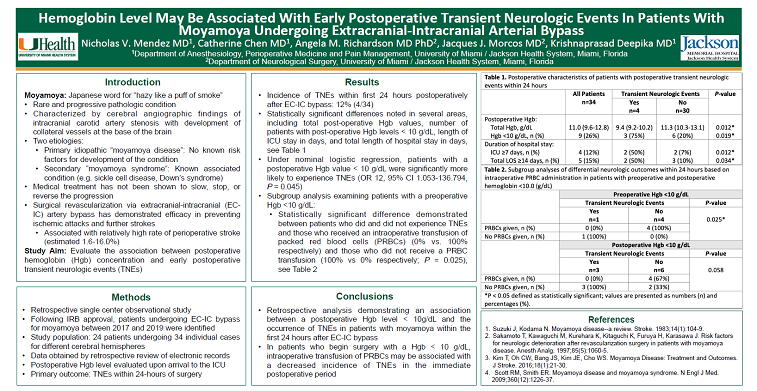2020 FSA Posters
P014: HEMOGLOBIN LEVEL IS ASSOCIATED WITH EARLY POSTOPERATIVE TRANSIENT NEUROLOGIC EVENTS IN PATIENTS WITH MOYAMOYA UNDERGOING EXTRACRANIAL-INTRACRANIAL ARTERIAL BYPASS
Nicholas V Mendez, MD; Catherine Chen, MD; Angela M Richardson, MD, PhD; Jacques J Morcos, MD; Krishnaprasad Deepika, MD; University of Miami Miller School of Medicine/Jackson Memorial Hospital
Introduction: Moyamoya, a Japanese word meaning “hazy like a puff of smoke,” is the term used to describe a rare and progressive pathologic condition characterized by cerebral angiographic findings of intracranial carotid artery stenosis with development of collateral vessels at the base of the brain. Clinical presentation occurs in the form of neurologic events and medical treatment has not been shown to slow, stop, or reverse the progression of moyamoya. Surgical revascularization in the form of extracranial-intracranial (EC-IC) artery bypass has demonstrated efficacy in preventing ischemic attacks and further stroke. EC-IC bypass is associated with a relatively high rate of perioperative stroke with an estimated 1.6-16.0% of patients developing permanent neurologic deficits postoperatively. This retrospective single center observational study aims to evaluate the association between postoperative hemoglobin (Hgb) concentration and early postoperative transient neurologic events (TNEs).
Methods: Following approval by the institutional review board, consecutive patients undergoing EC-IC bypass between 2017 and 2019 were identified, resulting in a study population of 24 patients undergoing 34 individual cases for different cerebral hemispheres. Postoperative Hgb level was evaluated upon arrival to the intensive care unit (ICU) and the primary outcome was the occurrence of TNEs within the first 24-hour period.
Results: The incidence of TNEs within 24 hours postoperatively was 12% (4/34). Statistically significant differences were demonstrated between patients who did and did not experience TNEs in regards to postoperative Hgb value (9.4 vs. 11.3 g/dL respectively; P=0.012), total percentage of patients with postoperative Hgb <10g/dL (75% vs. 20% respectively; P=0.019), percentage of patients experiencing an ICU stay ≥7 days (50% vs. 7% respectively; P=0.012), and percentage of patients experiencing a total length of hospital stay ≥14 days (50% vs. 10% respectively; P=0.034), see Table 1. Under nominal logistic regression, patients with a postoperative Hgb value <10g/dL were significantly more likely to experience TNEs (OR 12, 95% CI 1.053-136.794, P=0.045). In a subgroup analysis specifically examining patients with a preoperative Hgb <10g/dL, a statistically significant difference was demonstrated between patients who did and did not experience TNEs and those who received an intraoperative transfusion of PRBCs (0% vs. 100% respectively) and those who did not receive a transfusion (100% vs 0% respectively; P=0.025), see Table 2.
Conclusions: This study demonstrates the association between a postoperative Hgb level <10g/dL and the occurrence of TNEs in patients with moyamoya within the first 24 hours after EC-IC bypass. In patients who begin surgery with a Hgb <10g/dL, intraoperative transfusion of PRBCs may be associated with a decreased incidence of TNEs in the immediate postoperative period.



